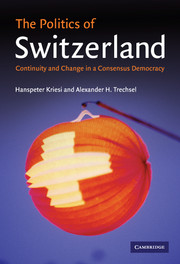Book contents
- Frontmatter
- Contents
- List of figures
- List of tables
- Preface
- List of abbreviations
- 1 The development of the modern Swiss nation-state
- 2 Neutrality
- 3 Federalism
- 4 Direct democracy
- 5 The Swiss system of government
- 6 The party system
- 7 Interest associations and labour relations
- 8 The decision-making process
- 9 Economic policy: liberalization under constraints
- 10 Social policy: the Swiss welfare state
- 11 Foreign policy: Switzerland and the EU
- Appendix
- References
- Index
5 - The Swiss system of government
Published online by Cambridge University Press: 05 September 2012
- Frontmatter
- Contents
- List of figures
- List of tables
- Preface
- List of abbreviations
- 1 The development of the modern Swiss nation-state
- 2 Neutrality
- 3 Federalism
- 4 Direct democracy
- 5 The Swiss system of government
- 6 The party system
- 7 Interest associations and labour relations
- 8 The decision-making process
- 9 Economic policy: liberalization under constraints
- 10 Social policy: the Swiss welfare state
- 11 Foreign policy: Switzerland and the EU
- Appendix
- References
- Index
Summary
Introduction
This chapter provides an overview of the Swiss system of government and its two branches, the legislative and the executive. We will first present the structure and functioning of the Federal Parliament before having a closer look at the Federal Council, the executive body of the Confederation. This will be followed by a discussion of the relationship between the two and the current problems they are facing. We will conclude this chapter with an assessment of possible options for reforming the Swiss system of government.
The Federal Parliament
In chapter 3 the reader was provided with the most basic information concerning the set-up of the Federal Parliament. In this chapter we go further and present a more detailed picture of the Swiss Parliament's structure and role. The Federal Parliament is the highest authority of the Confederation, subject to the rights of the people and the cantons. In academic literature, a classic distinction is made between parliaments of work and parliaments of debate. While the latter could characterize the British House of Commons, where major political decisions are taken following plenary discussions, the Swiss Parliament clearly belongs to the first category: it is a parliament of work; the bulk of work is undertaken within committees, outside the plenary chamber (Linder 1999: 195; Ochsner 1987). Other chief examples of parliaments of work include the US Congress and the European Parliament. According to Lüthi (1987: 88), Swiss MPs spend more than 70 per cent of their time working for parliamentary committees.
- Type
- Chapter
- Information
- The Politics of SwitzerlandContinuity and Change in a Consensus Democracy, pp. 69 - 83Publisher: Cambridge University PressPrint publication year: 2008



